|
Click
on the date below the image for an enlarged view:
1970
- 1974
COMET
KAHOUTEK

Jan.
7, 1974, 135mm
f/4, 1min on Tri-x film, Highland Michigan (in deep snow!)
1975
- 1979
COMET
KOBAYASHI BERGER MILLON

July
29, 1975, 135mm
f/2.8, 10 mins on Tri-x film, Highland Michigan
COMET
WEST

March
7, 1976, 135mm
f/2.8, 1 min on Tri-x film, Highland Michigan
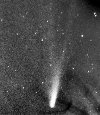
March
11, 1976, 135mm
f/2.8, 10 mins on Tri-x film, two negs superimposed to reduce
grain.
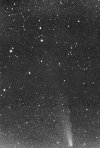
March
27, 1976, 135mm
f/2.8 10 mins on Tri-x film, Highland Michigan
COMET
D'ARREST

July
31, 1976, 135mm
f/4, 15 mins on Tri-x film, Highland Michigan
1980
- 1984
COMET
BRADFIELD (1980t)

January
14, 1981, 10"
f/6 Newtonian, 5mins on Ektachrome 400, Chino Valley, Az
COMET
IRAS-ARAKI-ALCOCK

May
10, 1983, 135mm
f/4 10mins on Tri-x film, Black Canyon City, Az
1985
- 1989
COMET
BRADFIELD

December
20, 1987, 8"
f/1.5 Schmidt Camera, 2415 film, 10mins, 50cc Yellow filter,
Black Canyon City, Az
November
12, 1987, 16"
f/4.5 Newtonian, 15mins on Konica SR400 film, Black Canyon City
November
19, 1987, Objective
Prism Spectra, 400mm f/6.3, 20mins on Konica SR1600

November
19, 1987, 8"
f/1.5 Schmidt Camera, 15mins on Fuji RD100 film, Black Canyon
City
COMET
HALLEY

January
12, 1986, Objective
Prism Spectra, 400mm f/6.3, 25mins on 3M1000 film

March
15, 1986, 7"fl
f/2.5 Aero Ektar, 4mins on Ektachrome 400, Black Canyon City

March
8, 1986, 7"fl
f/2.5 Aero Ektar, 30 mins on Fuji RD100, Queensland Australia

April
29, 1986, With
Corvus, 50mm f/2.8, 30 mins on Fuji RD100, Dugas Az
COMET
BRORESEN METCALF

September
10, 1989, 8"
f/1.5 Schmidt Camera, 4mins on Hypered 2415, Payson

August
14, 1989, 14"
f/5 Newtonian, 15mins on Hypered 2415, offset guided on stars
to keep comet motionless.

August
29, 1989, 14"
f/5 Newtonian, 15mins on Hypered 2415, Payson, AZ
1990
- 1994
COMET
AUSTIN

April
27, 1990, 8"
f/1.5 Schmidt Camera, 5mins on Hypered 2415, Payson

May
4, 1990, 16"
f/4.5 Newtonian, 5mins on Ektar 1000 film, Payson

May
6, 1990, Objective
Prism Spectra, 400mm f/6.3, 15mins on Ektar 1000, Payson
COMET
LEVY

August
22, 1990, 14"
f/5 Newtonian, Offset Guided on stars, 9 mins on Hypered 2415

February
9, 1991, With spectacular
long thin anti tail, 8" f/1.5 Schmidt Camera, 5 mins on
Hypered 2415 film, Payson

September
20, 1990, With
M15, 8" f/1.5 Schmidt Camera, 6mins on Fuji HG400 film,
Payson
COMET
METCALF BREWINGTON

January
18, 1991, 6"
f/3.6 Schmidt Newtonian, 15 mins on Hypered 2415 film, Payson
1995
- 1997
COMET
HYAKUTAKE

4/11/96, 8" f/1.5 Schmidt Camera,
Fuji 800 Super G Plus film, 4mins, Payson, Az
COMET
HALE BOPP

August
17, 1996

September
26, 1996, Taken
DURING lunar eclipse totality, 12.5" f/5 Newtonian, Kodak
Pro400ppf, 20m, Payson, Az

September
26, 1996, High
Pass Filtered to show numerous jets, Taken DURING lunar eclipse
totality, 12.5" f/5 Newtonian, Kodak Pro400ppf, 20m, Payson,
Az

September
7, 1996, 12.5"
f/5 Newtonian, Kodak Pro400ppf, 20m, Payson, Az

September
7, 1996 , High
Pass Filtered to reveal jets, 12.5" f/5 Newtonian, Kodak
Pro400ppf, 20m, Payson, Az
March 21 to April
13 images (Newest Latest Uploads)

March
25, 1997 - 135mm
f/4, 10 mins on Kodak Pro400ppf. The comets still horizontal
tail was a very striking sight in arizona, the broadening fan
tail was lengthening daily, and the blue ion tail showed much
ray detail, even in the 135mm.

March
26, 1997 - 135mm
f/4, 10 mins on Kodak Pro 400ppf. The next day, changes can be
seen especailly in the gas tail.
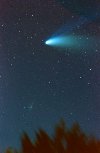
March
27, 1997 #1 - 135mm
f/4, 5 mins on Kodak Pro 400 ppf. This spectacular pairing with
the Andromeda galaxy shows just how big and bright the comet
really is. Ive always wanted to get a bright comet in the same
picture with M31, because it is so familiar as the one of the
brightest deep sky objects in the sky.

March
27, 1997 #2- 50mm
f/2.8, 5 mins on Kodak Pro 400ppf. Later on, after the comet
made its unique pairing with the Andromeda galaxy, I got this
image with a wide angle lens, matching the naked eye appearance.
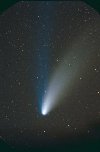
March
27, 1997 #3 - 5.5"
f/1.65 schmidt camera, 5 mins on Kodak Pro 400 ppf. This and
the next image taken consectutively show the much broadening
of the ion tail, with a rapid increase in detail. This trend
would continue, making the tail much shorter and fainter over
the next few weeks.

March
27, 1997 #3 - 5.5"
f/1.65 schmidt camera, 5 mins on Kodak Pro 400 ppf. Portrait
orientation of above shot, taken right afterwards.

March
28, 1997 - 135mm
f/4, 5 mins on Kodak Pro 400 ppf. More broadening of the ion
tail, but the rays in the tail are separating to make them each
more distinct.

March
28, 1997 - 5.5"
schmidt camera, two 5 minutes exposures combined in the darkroom.
This high contrast and detailed image is first of a pair showing
excellent detail in the plasma tail of the comet, but nearly
a featurless dust tail. This is a far cry from the March 15th
images that show the synchronic bands.

March
28, 1997 - 5.5"
schmidt camera, two 5 minutes exposures combined in the darkroom.
The film holder of the schmidt was rotated 90 degrees (always
N-S on one edge!) to reveal yet another aspect of this specatular
comet.

March
29, 1997 - 135mm
f/4, 5 mins on Kodak Pro 400 ppf. I have two images to offer
on this date, this one shows the general aspect of the tails
with the double cluster in Perseus on the upper right.

March
29, 1997 - 50mm
f/1.4, 1 min. This is one of those shots you always wanted to
take right? I set the camera up in my living room and shot the
setting comet through the window! Perhaps not everyone wants
such a shot, but Im not just everyone...

April
6, 1997 - 135mm
f/4, two 5 minute exposure combined in the darkroom. This excellent
pairing of deep sky objects, shows M34 in Perseus in the tail
of the comet very near the head. The comets blue ion tail continues
to broaden out, but the dust tail is becoming very long, some
20 degrees naked eye.
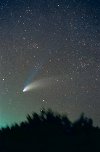
April
6, 1997 -50mm f/2.8,
5 mins on Kodak Pro 400 ppf. ( you probably are getting the idea
by now, I REALLY like this film!) the comets beautiful aspect
with the Perseus association and double cluster can be seen here.

April
6, 1997 - 5.5"
f/1.65 Schmidt camera, two 5 minute exposures combined in the
darkroom. This is the first of a pair of images showing the cluster
M34 within the comets dust tail. Note the colors of the stars
in the cluster, and how it contrasts beautifully with the comets
rich blues and yellows.

April
6, 1997 - 5.5"
f/1.65 Schmidt camera, two 5 minute exposures combined in the
darkroom. Second of a pair, taken the same way.

April
8, 1997 - Setting
sequence. 50mm f/2.8 lens. This shot was taken by opening the
cameras shutter while on a fixed tripod, and only uncovering
the lens for 20 seconds every 15 minutes. the resultant combined
images shows a very nice action portrait of the comet setting
in the west.
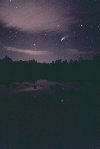
April
13, 1997 - 24mm
f/2.8 lens, 45 seconds on Kodak Pro 400 ppf. This shot was taken
by myself and photographer Vince Mele up on the Mogollon Rim
in Northern arizona. We set up the tripod next to a very still
pond, and shot the comet and its reflection in the water while
cars whizzed by just behind us.
March 8 to March
20 images

March
8, 1997 - 5.5"
f/1.65 schmidt camera, two pairs of 5 minutes expoures on Kodak
Pro400ppf sandwhiched and then combined to for this composite
of two fields. Hints of the Syncrhones are still present, and
the gas tail shows abundant ray detail.
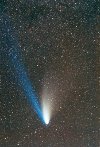
March
11, 1997 - the
comet with the cocoon nebula in between the two tails was the
attraction this night, this 135mm f/4 shot was a pair of 5 minute
exposures combined in the darkroom to make this composite with
reduced grain and improved color saturation. Pro 400 ppf.
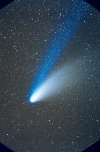
March
11, 1997 - 5.5"
f/1.65 schmidt camera. A close up of the comet on this date shows
a strengthening of the faint paralell bands in the tail (syncrones?)
and a dramatic wrap around blue ion tail that extends off the
9 degree field. Pro 400ppf.
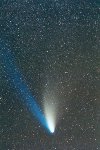
March
15, 1997 - 135mm
f/4, two 5 minute exposures combined on Pro 400ppf. This is the
date that has the best dust tail detail so far, excellent banding
is visible even in this wide angle shot taken in the morning
sky.

March
15, 1997 - 5.5"
f/1.65 schmidt camera. First of pair in which the synchrones
(?) are at their maximum extent. Comet West in 76 showed similar
tail development, but few comets since have anything like this.
Pro 400ppf pair of 5 minutes shots combined in darkroom.

March
15, 1997 - 5.5"
f/1.65 schmidt camera. Second of pair with schmidt film holder
rotated 90 degrees. As is with all schmidt shots I present, the
edges match the cardinal directions.

March
15, 1997 - First
Evening Shots from Payson. This 135mm f/4 shot was for 5 minutes
on Kodak Pro 400 ppf, and shows the unique "horizontal tail"
so charecteristic of this comets initial evening apparitions.
Just barely above the tree tops, it was only visible for about
ten minutes in the bright twilight.

March
15, 1997 - Objective
prism shot of the comet. A 400mm f/6.3 lens was shot into a prism
at the comet, producing this image. The camera was stationary,
and the comet and stars were allowed to trail for 5 minutes perpendicular
to the prisms dispersion. The extra yellow spectral line seen
was the cause of the comets nucleus to take on a yellowish tint
to the naked eye. Pro 400ppf.

March
15, 1997 - Objective
prism shot of the lights of Payson, some 4 miles distant. Compare
this to the above image, and you will see that the prism does
a fair job at resolving the spectra of bright sources.

- Morning Rising Sequence.
This is one of my most favorite shots so far of the comet, it
was taken by putting the camera on a standard tripod, unguided,
and opening the shutter with the lens cap on. Then I exposed
the film for 20 seconds every 15 minutes seven times. The shot
was with a 50mm lens at f/2.8 on Kodak Pro 400 ppf, and shows
the extinction band, even present at my 5150 foot elevation yellowing
the comet near the horizon. The goal was to also get the tail
without the head as the comet rose, which is seen here as well
just popping over the Mogollon Rim in Northern Arizona, which
is some 20 miles north of my house.

March
18, 1997 - Evening
shot same day as above morning shot showing the progress of the
comets evening apparition setting over the trees. Hints of the
ion tail are finally appearing, and this shot also reveals the
unique aspect of the horizontal tail in the sky after sunset.
135mm f/4, 5 mins on Kodak Pro 400ppf.

March
20, 1997 - 50mm
f/2.8, 5 mins on Kodak Pro 400ppf. First of pair of shots taken
in the morning sky. The comet was still most spectacular in the
morning, and this rising shot exactly matched the naked eye impression
(except for color!) as the comet rose over the Mogollon Rim.

March
20, 1997 - 50mm
f/2.8, 5 mins on Kodak Pro 400ppf. Second of 50mm shots, same
data, and with camera oriented in "portrait mode".
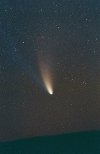
March
20, 1997 - 135mm
f/4, 5 mins on Kodak Pro400ppf. First of two images with the
135mm of the comet rising over the Mogollon Rim in Northern Arizona.
The low altitude does have a detrimental effect on the visibility
and contrast of the tails, but perhaps from a aesthetic point
of view, the Rim and reddening background from the oncoming surise
make up for it!
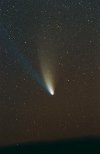
March
20, 1997 - 135mm
f/4, 5 mins on Kodak Pro400ppf. Second of two images with the
135mm of the comet rising over the Mogollon Rim in Northern Arizona.
As sunrise approaches the ultra red sensitvity of the Pro 400
film really brings out the ruddy sky.

- ALL SKY HUBCAP. Now heres
what can be best described as a self portrait of the dedicated
comet photographer in the morning sky! This shot was taken with
my 135mm f/4 lens aimed into a 10 inch automobile hubcap proped
up on a chair and facing east. The comet can be seen in all its
glory, rising the Mogollon Rim, and the dark shadowy figures
is me next to my schmidt camera mount standing perfectly still
for 5 minutes. (not an easy thing to do for me!)
March 2 to
March 8 images
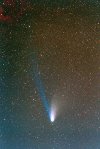
- 135mm f/4, 10 mins on
Fuji 400 Super G Plus film. From Payson, Az by the author from
his balcony. Here we can see the rapidly broadening plasma tail
reaching up into the Cygnus region. At the upper left is NGC7000,
the North America Nebula.

- 5.5" f/1.65 Schmidt
Camera, 5 mins on Kodak Pro 400 ppf film. Second in a sequence
of images with the schmidt, with the film holder rotated 90 degrees
from the above image. Note the brownish-purple color of the dust
component in the head and tail. This unusual color is a combination
of the swan band component and an absorption effect similar to
smog in the vicinity of the coma.

March
3, 1997 - 12.5"
f/5 Newtonian, 30 seconds on Kodak Pro 400ppf film, from the
authors backyard observatory. This is part one of a three part
sequence showing the inner coma and near nucleus features. The
sunward jet of material that has caused so much excitement is
seen clearly here, and just below it in this shot, a few dark
rings can be seen from the spiral jet in the nucleus causing
alternating waves of light down the jet.

March
3, 1997 - 12.5"
f/5 Newtonian, 60 seconds on Kodak Pro 400ppf film, from the
authors backyard observatory. Part two of this sequence shows
the exciting and beautiful nature of the hoods in the coma. The
jet is seen to curve backward from the nucleus, and become a
very bright ray in the tail. At first this ray was connected
with the gas tail only, but later on became a separate entity
seen as a bright rib in the center of the tail.

March
3, 1997 - 12.5"
f/5 Newtonian, 4 minutes on Kodak Pro 400ppf film, from the authors
backyard observatory. This shot reveals the magnificence and
incredible wealth of detail visible near the nucleus. The green
leading edge of the coma can be seen clearly here, emanating
from swan bands, and the very unusual purplish brown color of
the inner coma is in evidence.

March
5, 1997 - 50mm
f/2.8, 5 mins on Fuji 400 Super G Plus. As the comet moved northward,
the long blue ion tail became clearly shorter, yet still swept
past the most spectacular portions of the Cygnus Milkyway.
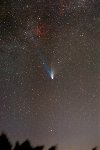
March
5, 1997 - 50mm
f/2.8, 5 mins on Fuji 400 Super G Plus. Second image taken minutes
after the last shot. Here the comet is seen in rising above the
tree tops, at the top of the frame is gamma Cygni with its associated
red emission nebulosities.

March
5, 1997 - 5.5"
f/1.65 Schmidt Camera, two 5 minute exposures combined in the
darkroom, taken with Kodak Pro400 ppf film. The wonderful dust
fan is growing very rapidly, and will soon overtake the gas tail
as far as grandeur. Note the development of several sub rays
in the gas tail, which were not visible days before.

March
5, 1997 - 5.5"
f/1.65 Schmidt Camera, two 5 minute exposures combined in the
darkroom, taken with Kodak Pro400 ppf film. Second exposure on
this date with the schmidt, with the film holder rotated 90 degrees.
Notice that while the earlier shots revealed a greenish leading
edge on the coma, this one appears bluish.

March
6, 1997 - ROCKET
LAUNCH WITH HALE BOPP - 50mm f/1.4, 15 seconds on Kodak Pro400
ppf. I was driving to work and happened to have a camera in the
jeep, when the rocket from White Sands New Mexico went up to
the right of the comet. It was still dark enough to get some
rewarding shots of the comet with a still expanding multicolored
contrail cloud.

March
7, 1997 - 135mm
f/4, 10 minutes on Kodak Pro400ppf. This is actually two 5 minute
exposures sandwiched in the digital darkroom to produce
this enhanced composite image. The 135mm is perfect for showing
the long blue ion tail in addition to the compact, but detailed
dust appendage.

March
7, 1997 - 135mm
f/4, 5 minutes on Kodak Pro400ppf. This is a single frame of
the above image to show the difference that the sandwiching negatives
makes in the comets image. The technique reduces grain, improves
contrast, and makes detail much easier to see.

- Synchrones (?) in the
dust tail. 5.5" f/1.65 schmidt camera, two 5 minute exposures
combined. Besides the fabulous detail the comet is presenting
to us astrophotographers in the gas tail, now we are starting
to see some fine structure in the dust tail. This was the first
image I saw the fine linear streaks in the dust tail ever, and
it will be exciting to track their development.

March
7, 1997 - Synchrones
(?) in the dust tail. 5.5" f/1.65 schmidt camera, two 5
minute exposures combined. Second image taken on same date with
the schmidt film holder rotated 90 degrees.

March
8, 1997 - Rising
Over the Mogollon Rim in Northern Arizona. 50mm f/2.8 lens, 2mins
on Fuji 400 Super G Plus. Although the dust extinction is taking
its toll, the comets nucleus rose halfway through this exposure
of what was intended to be a shot of the tail rising by itself.
Oh well, Ill have more chances!

March
8, 1997 - 50mm
f/2.8, 5 mins on Fuji 400 Super G Plus. Besides being inferior
to the Kodak emulsion for shooting comets, the colors are poor
too. However, this comparison is essential to get the best images
of the comet. The comets very blue tail is seen arching into
the Cygnus milkyway.

March
8, 1997 - 5.5"
f/1.65 Schmidt, two 5 min exposures combined. The rich detail
seen in the dust tail continues as the fine bands increase in
number. The gas tail is exquisite. the fine rays and secondary
rays reveal a very active comet is coming.

March
8, 1997 - 5.5"
f/1.65 Schmidt, two 5 min exposures combined. Second image in
pair, with film holder rotated 90 degrees to reveal a different
aspect of the tail. This shot confirms the fine features in the
dust tail.
February 97 Images

February
7, 1997 - 5.5"
schmidt camera, 5mins on Kodak Pro400 ppf film. From Payson Az,
by the author from his balcony.

February
15, 1997 - 50mm
f/2.8 lens, 5mins on Kodak Pro 400ppf. This closely matches the
appearance in binoculars.

February
15, 1997 - 50mm
f/2.8 lens, 5mins on Kodak Pro 400ppf. Another shot with the
comet higher up in the sky.

February
15, 1997 - 5.5"
schmidt camera, two 5 minutes shots combined by sandwiching negatives.
Note the extreme blue color of the plasma tail, and excellent
separation of dust tail.

February
15, 1997 - 5.5"
schmidt camera, two 5 minutes shots combined by sandwiching negatives.
This second shot taken after the last shot is with the film holder
oriented 90 degrees for more tail detail.

February
15, 1997 - 12.5"
f/5 newtonian, 90 seconds exposure. Kodak Pro400ppf. This short
exposure shows the inner details of the coma with its parabolic
envelopes.
Note that in
these images, the yellow dust tail includes the anti-tail, now
spreading out into a large fan that still points sunward, and
also note the electric arc blue ion tail extending up to three
degrees from the head.
January 97
Images

January
17, 1997, #1 -
5.5" f/1.65 schmidt camera, 4mins on Kodak Pro400ppf film,
from Payson, Az, by the Author.

January
17, 1997, #2 -
5.5" f/1.65 schmidt camera, 4mins on Kodak Pro400ppf film,
from Payson, Az, by the Author

January
17, 1997, #3 -
Same as above, but here I have combined in the darkroom two negatives
to make one image to reduce grain and improve on details.

January
19, 1997, #1 -
5.5" f/1.65 schmidt camera, 4mins on Kodak Pro400ppf film,
from Payson, Az, by the Author

January
19, 1997, #2 -
5.5" f/1.65 schmidt camera, 4mins on Kodak Pro400ppf film,
from Payson, Az, by the Author

January
19, 1997, #3 -
Same as above, but here I have combined in the darkroom two negatives
to make one image to reduce grain and improve on details.
More Comet Hale Bopp
Latest uploads of images
from Four Peaks Road in Central Arizona of the comet rising in
a very reddish morning twilight just over Four Peaks Mountain.
The comet was 3rd magnitude, and exhibited a 1 degree tail in
7x50 binoculars. Here is a multi part rising sequence of that
event at 6:05 to 6:15 am MST. All shots are with a 135mm f/2.5
telephoto on a tracking mount on hypered Kodak Pro400ppf film.
Shot by the author. Please be certain to view them with a 24bit
viewer for best effect!
More January
97 Images

Hale
Bopp rising over Four Peaks, #1, 6:05am
 , . , .

Hale
Bopp rising over Four Peaks, #3, .

Hale
Bopp rising over Four Peaks, #4, .

Hale
Bopp rising over Four Peaks, #5, .

Hale
Bopp rising over Four Peaks, #6, .

Hale
Bopp rising over Four Peaks, #7, 6:15am
COMET
TABUR

October
13, 1996, 12.5"
f/5 Newtonian, Kodak Pro400ppf, 15m, Payson, Az

October
13, 1996, Note
M108 and M97 on right edge, 6" f/3.6 Schmidt Newtonian,
Kodak Pro400ppf, 10m, Payson, Az
Comet
Utsunamiya

October
31, 1997 - Yes,
while others were trick-or-treating, I was out shooting the comet!
This is a composite of five exposures, each five minutes in length
on Kodak Pro400 ppf that was hypered for 8 hours. Taken with
my 12.5" f/5 newtonian, the exposures are short due to the
comets very fast motion across the sky. I sandwiched the negatives
in the darkroom, (try that with five 10mb files sometime) and
aligned the comets nucleus. Even in five minutes, the nucleus
is trailed a very tiny amount, and the gap between the star trails
is because of this. Notice the beautiful emerald green color.
Comet Drawings
on the night of November 1-2, 1997 at Sentinel Star Party
UPLOADS - October
10, 1997
Comet Hale Bopp

September
22, 1997 - Drawing
with an 8" f/5 newtonian on just before morning twilight.
The comet was extremely low in the east south east, however good
detail could be glimpsed.

September
27, 1997 #1 - 135mm
f/2.5 6 mins on Kodak Pro 400 ppf from Payson Arizona by Chris
Schur. The open cluster to the right of the comet is NGC2477
in Puppis. The comet was only 10 degrees up when these three
shots were taken!
 - 135mm f/3.5 2 mins on Kodak Pro
400 ppf from Payson Arizona by Chris Schur. - 135mm f/3.5 2 mins on Kodak Pro
400 ppf from Payson Arizona by Chris Schur.

September
27, 1997 #3- 135mm
f/3.5 4 mins on Kodak Pro 400 ppf from Payson Arizona by Chris
Schur.

October
5, 1997 - 5.5" f/1.65 Schmidt Camera, 4 mins on Kodak
Pro 400 ppf from Payson Arizona by Chris Schur. The comet is
seen as it skimmed the tree tops (green dark shape on bottom).
This spectacular grouping with the open cluster NGC2477 in Puppis
(fainter, richer cluster) and NGC2451 ( the very sparse cluster
on the right edge, with bright orange star), and NGC2546 (the
faint large group to the uppermost left). I had only about half
an hour to get the shot composed, find a guide star and begin
shooting because it had to be timed to go between tree branches.
The mounting was 14 feet off the ground, on my back balcony as
well, so lets just say it was very low on the south eastern
horizon! The comet photographed as a sky blue color in the coma,
indications of some gas activity still in progress. The comet
was 5th magnitude, and very faintly visibly to the unaided eye
as a large patch about half a degree across. The tail seen here
is 1.5 degrees long or so.

October
14, 1997 -12" f/5 Newtonian, 2 minutes exposure on Kodak
Pro 400 ppf from Payson Arizona by the Author. This short exposure
reveals a north-south enlongation of the coma, with a westward
pointing tail glow. This very strange appearance has persisted
for several weeks now. This will be my final shot with the 12
inch, since it was only 2 degrees up above the distant trees.
The seeing was very poor as you may guess, but the comet was
mag 5.5 and still detectable with my naked eyes. The yellowish
color of the comet seen here is probably due to dust from atmospheric
extinction.
Comet
Meuneir Depouy

September
27, 1997 - Drawing
with my 16" f/4.4 newtonian from our observing site on Zane
Gray Highway up on the Mogollon Rim at 6500 feet. Observing with
Tom Polakis and Bernie Sanden.
Comet
Ikeya-Zhang
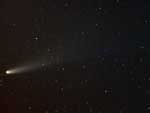 Comet IZ
March 31 in West
Comet IZ
March 31 in West
|
 Comet IZ and M31
Comet IZ and M31
|
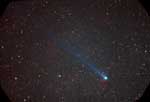 Comet IZ and NGC7830
Comet IZ and NGC7830
|
Comet
Bradfield
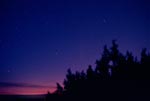 Comet Bradfield
4/27/04
Comet Bradfield
4/27/04
Comet
Neat
Comet
Linear T7
 Comet Linear T7
Jan 17th, 04
Comet Linear RX14
Comet Linear T7
Jan 17th, 04
Comet Linear RX14
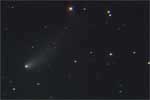 Comet Linear RX14
Comet Linear RX14
Comet
Machholz Q2
|
Comet Bradfield 4/27/04
Comet Linear T7 Jan 17th, 04 Comet Linear RX14
Comet Linear RX14